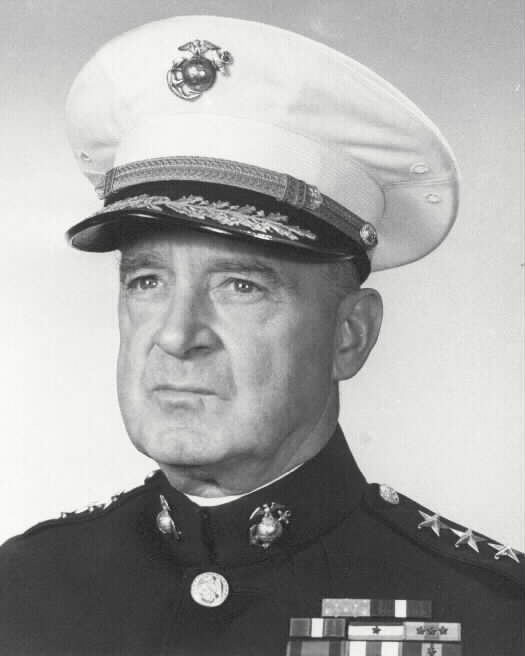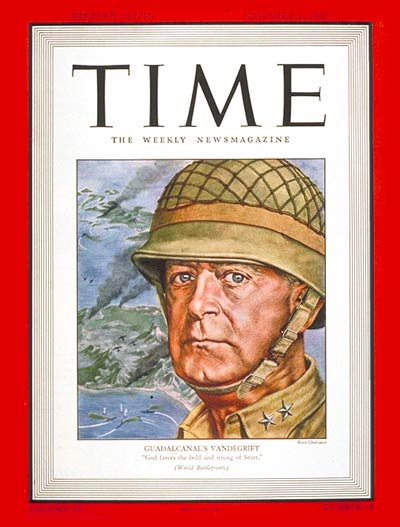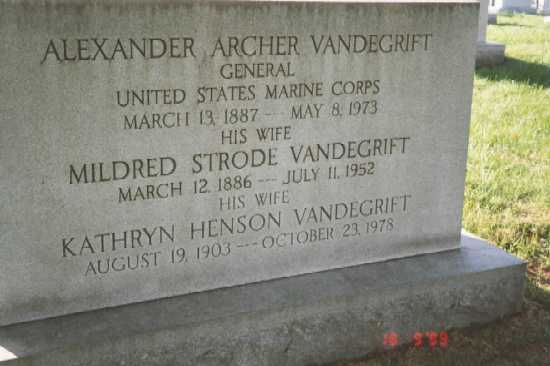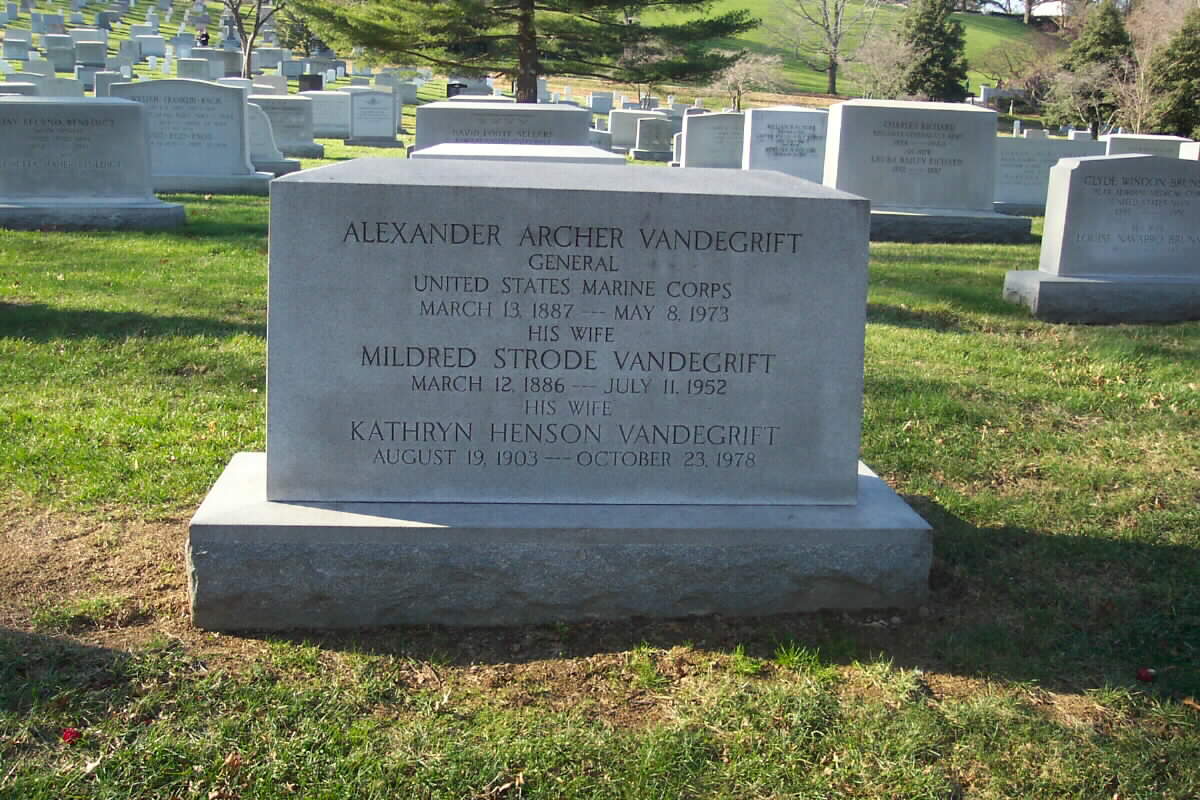General Alexander Archer Vandegrift, who earned the Medal of Honor in World War II, served as the eighteenth Commandant of the Marine Corps, from January 1, 1944 to January 1, 1948. The general commanded the First Marine Division, Reinforced, in the battle for Guadalcanal, and the First Marine Amphibious Corps in the landing at Empress Augusta Bay, Bougainville, during World War II.
For outstanding services as Commanding General of the First Marine Division, Reinforced, during the attack on Guadalcanal, Tulagi, and Gavutu in the Solomon Islands on August 7, 1942, he was awarded the Navy Cross, and for the subsequent occupation and defense from August 7 to December 9, 1942, was awarded the Medal of Honor. His citation for the latter reads in part:
“With the adverse factors of weather, terrain and disease making his task a difficult and hazardous undertaking, and with his command eventually including sea, land, and air forces of the Army, Navy, and Marine Corps, Major General Vandegrift achieved marked success in commanding the initial landings of the United States Forces in the Solomon Islands and in their subsequent occupation.
“His tenacity, courage and resourcefulness prevailed against a strong, determined and experienced enemy, and the gallant fighting spirit of the men under his inspiring leadership enabled them to withstand aerial, land and sea bombardment, to surmount all obstacles and leave a disorganized and ravaged enemy.
“This dangerous but vital mission, accomplished at the constant risk of his life, resulted in securing a valuable base for further operations of our forces against the enemy.”
General Vandegrift was born on March 13, 1887, in Charlottesville, Virginia. He attended the University of Virginia and was commissioned in the Marine Corps as a second lieutenant on January 22, 1909.
Following instruction as the Marine Officers’ School, Port Royal, South Carolina, and a tour of duty at the Marine Barracks, Portsmouth, New Hampshire, he went to foreign shore duty in the Caribbean area, where he participated in the bombardment, assault and capture of Coyotepe in Nicaragua. He further participated in the engagement and occupation of Vera Cruz, Mexico.
In December 1914, following his promotion to first lieutenant, he attended the Advance Base Course at the Marine Barracks, Philadelphia. Upon completion of schooling, he sailed for Haiti with the First Brigade and participated in action against hostile Cacos bandits at LeTrou and Fort Capois.
In August 1916, he was promoted to captain and became a member of the Haitian Constabulary at Port Au Prince, where he remained until detached to the United States in December 1918. He returned to Haiti again in July 1919, to serve with the Gendarmerie d’ Haiti as an Inspector of Constabulary. He was promoted to major in June 1920.
Major Vandegrift returned to this country in April 1923, and was assigned to the Marine Barracks at Quantico, Virginia. He completed the Field Officers’ Course, Marine Corps Schools in May 1926, following which he went to the Marine Corps Base, San Diego, California, as Assistant Chief of Staff.
In February 1927, he sailed for China where he served as Operations and Training Officer of the Third Marine Brigade with Headquarters at Tientsin. He was ordered to Washington, D. C., in September 1928, where he became Assistant Chief Coordinator, Bureau of the Budget. Following duty in Washington, he joined the Marine Barracks, Quantico, Virginia, where he became Assistant Chief of Staff, G-1 Section, Fleet Marine Force. During this assignment, he was promoted to lieutenant colonel in June 1934. Ordered to China in June 1935, Lieutenant Colonel Vandegrift served successively as Executive Officer and Commanding Officer of the Marine Detachment at the American Embassy in Peiping. He was promoted to colonel in September 1936.
Colonel Vandegrift reported to Headquarters Marine Corps, Washington, D. C., in June 1937, where he became Military Secretary to the Major General Commandant. In March 1940, he was appointed Assistant to the Major General Commandant, and the following month was promoted to brigadier general.
General Vandegrift was detached to the First Marine Division in November 1941 shortly before the outbreak of World War II. He was promoted to major general in March 1942, and in May sailed for the South Pacific area as Commanding general of the first Marine division to ever leave the shores of the United States. On August 7, 1942, in the Solomon Islands, he led ashore the First Marine Division, Reinforced, in the first large-scale offensive action against the Japanese.
In July 1943, he assumed command of the First Marine Amphibious Corps, and commanded this organization in the landing at Empress Augusta Bay, Bougainville, Northern Solomon Islands, on November 1, 1943. Upon establishing the initial beachhead, he relinquished command and returned to Washington, D. C., as Commandant-designate. On January 1, 1944, as a lieutenant general, he was sworn in as the eighteenth Commandant of the Marine Corps. On April 4, 1945, he was appointed general, with date of rank from March 21, 1945, the first Marine officer on active duty to attain four-star rank.
For outstanding services as Commandant of the Marine Corps from January 1, 1944 to June 30, 1946, the general was awarded the Distinguished Service Medal. He left active service on December 31, 1947, and was placed on the retired list, April 1, 1949.
General Vandegrift holds an honorary degree of Doctor of Military Science from Pennsylvania Military College, and honorary degrees of Doctor of Law from Harvard, Colgate, Brown, Columbia, and Maryland Universities and John Marshall College.
In addition to the Medal of Honor, Navy Cross, and Distinguished Service Medal, his decorations and Medals include: the Presidential Unit Citation with one Bronze Star, Solomon Islands, 1942; Navy Unit Commendation with one Bronze Star, Solomon Islands, 1943, and Okinawa, 1945; Expeditionary Medal with three Bronze Stars, Cuba, 1912, Nicaragua, 1912, Haiti, 1915-24, China, 1927-28; Nicaraguan Campaign Medal, Nicaragua, 1912; Mexican Service Medal, Mexico, 1914; Haitian Campaign Medal with one Star, Haiti, 1915 and 1919-20; Victory Medal with West Indies Clasp and one star, Haiti, 1918; Yangtze Service Medal, Shanghai, 1927; American Defense Service Medal, 1939-1941; Asiatic-Pacific Campaign Medal with four Bronze Stars, Solomon Islands, 1942-43; American Campaign Medal; and the World War II Victory Medal.
He has received the following foreign decorations: Haitian Distinguished Service Medal, Haiti, 1919-20; Medaille Militaire with one Silver Star, Haiti, 1920-21; Honorary Knight Commander, Military Division of the Most Excellent Order of the British Empire; Companion (Honorary) of the Military Division of the Most Honourable Order of the Bath, British Solomon Islands, 1942; Cruz de Aviacion de Primera Clase, Peruvian Government, 1944; Abdon Calderon of the 1st Class, Ecuador, 1944, Knights Grand Cross in the Order of the Orange-Nassau with Swords, Netherlands, 1945; the Order of Pao-Ting (Precious Tripod) with Special clasp, China, 1947; and the Legion of Honor (Grand Officer), France.
His first wife, Mildred Strode Vandegrift (March 12, 1886-July 11, 1952), his son, Alexander Archer Vandegrift, Colonel, United States Marine Corps, who was badly wounded on Iwo Jima in World War II (May 27, 1911-1969) and his second wife, Kathryn Henson Vandegrift (August 19, 1903-October 23, 1978), are buried with him.
Michael Robert Patterson was born in Arlington and is the son of a former officer of the US Army. So it was no wonder that sooner or later his interests drew him to American history and especially to American military history. Many of his articles can be found on renowned portals like the New York Times, Washingtonpost or Wikipedia.
Reviewed by: Michael Howard





